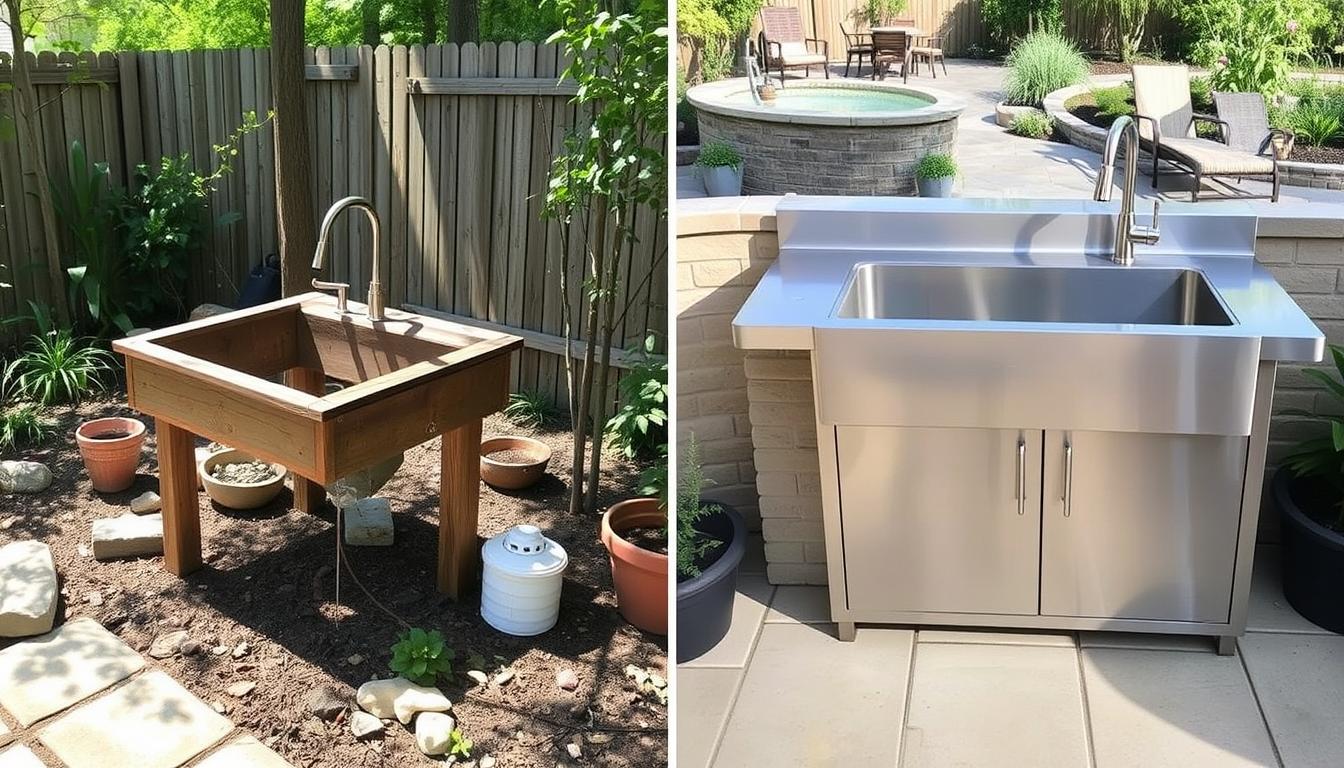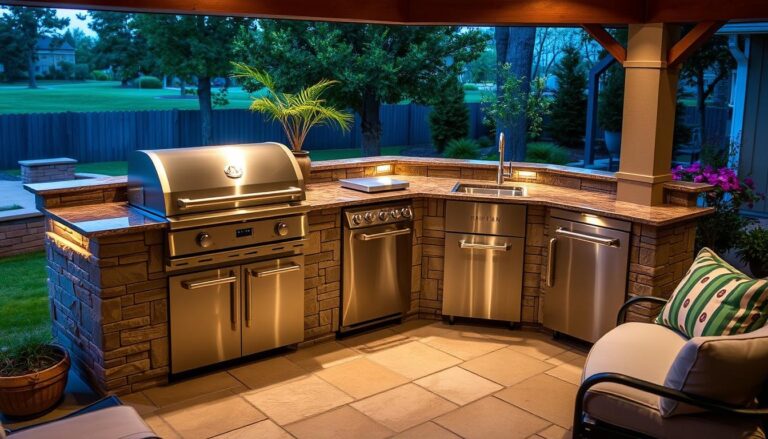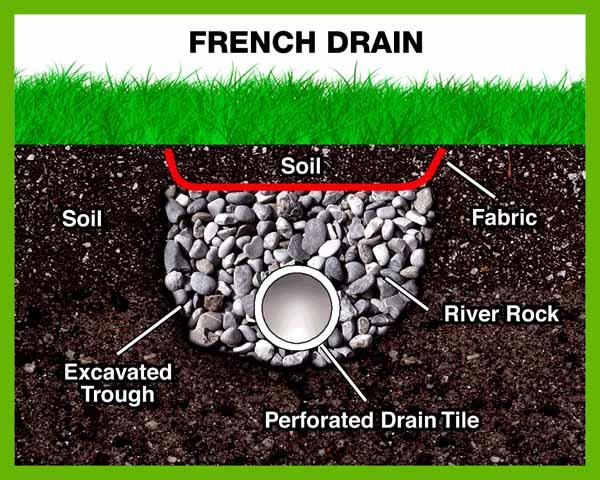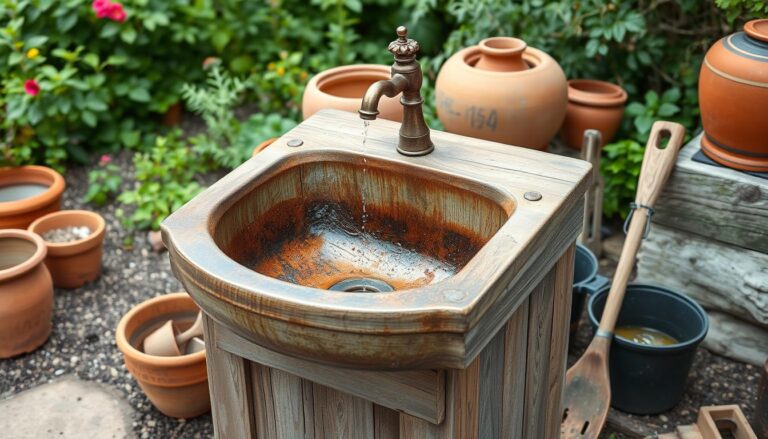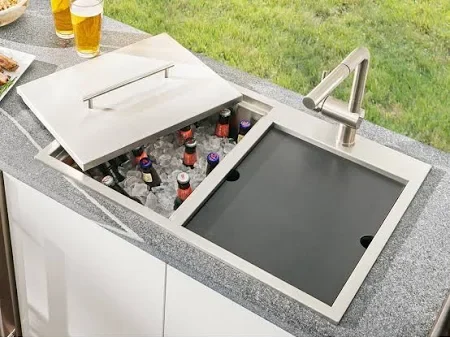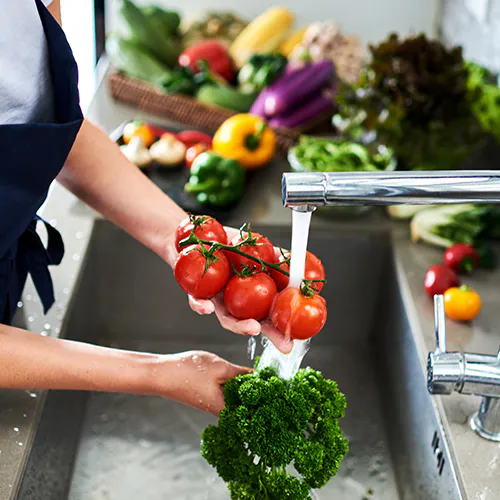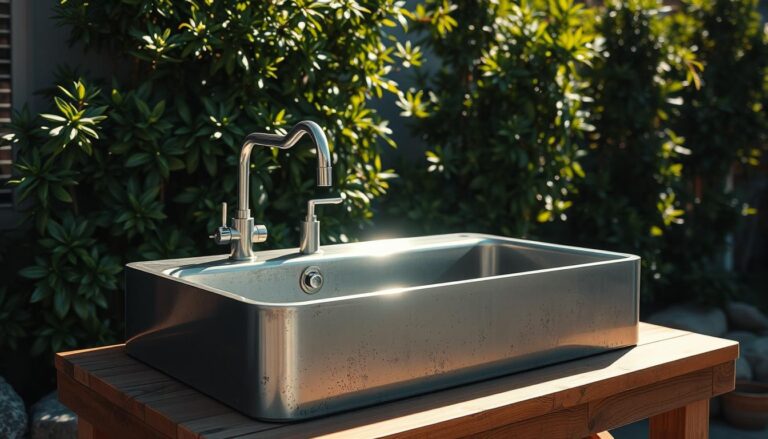DIY vs Pre-Built Outdoor Sink: 7 Key Differences You Must Know Before Buying
Designing your dream outdoor kitchen or garden workspace often starts with one essential feature — the outdoor sink. Whether you’re washing fresh garden produce, cleaning tools, or prepping food for a backyard BBQ, having a convenient outdoor kitchen sink can make all the difference. But when it comes to setting one up, homeowners often face a tough choice: Should you build your own DIY outdoor sink station or invest in a pre-built outdoor sink setup?
In this guide, we’ll compare DIY vs pre-built outdoor sinks to help you decide which option fits your space, budget, and lifestyle. You’ll learn the pros and cons of each, practical installation tips, and how to choose the right materials for long-lasting outdoor performance. Whether you love a good DIY project or prefer a ready-made solution, this article will make sure your outdoor sink station works perfectly for your needs — stylish, functional, and built to last.
Why Your Backyard Needs an Outdoor Sink
Before diving into the DIY vs pre-built debate, let’s consider why an outdoor sink is such a valuable addition to your backyard space:
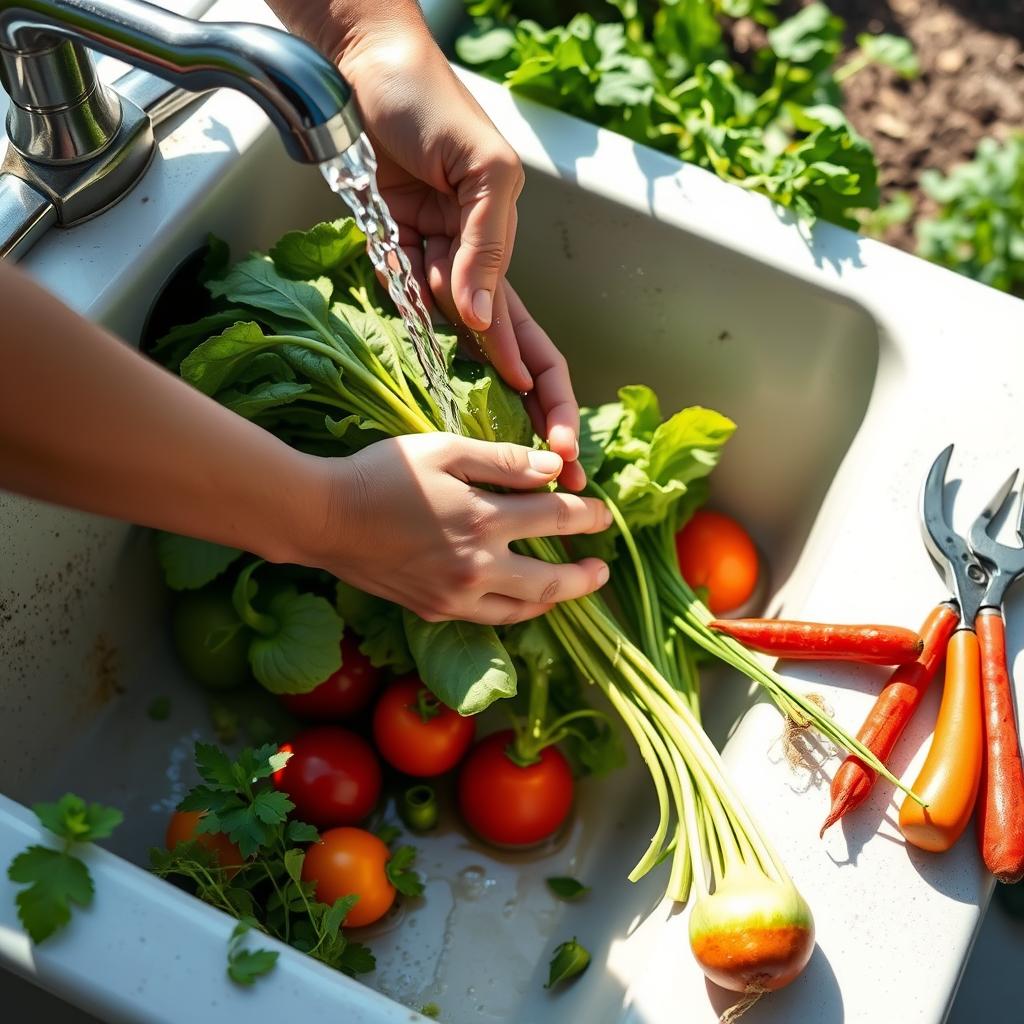
Gardening Convenience
Rinse vegetables, clean tools, and wash your hands without tracking dirt into your home. An outdoor sink keeps gardening messes where they belong—outside.
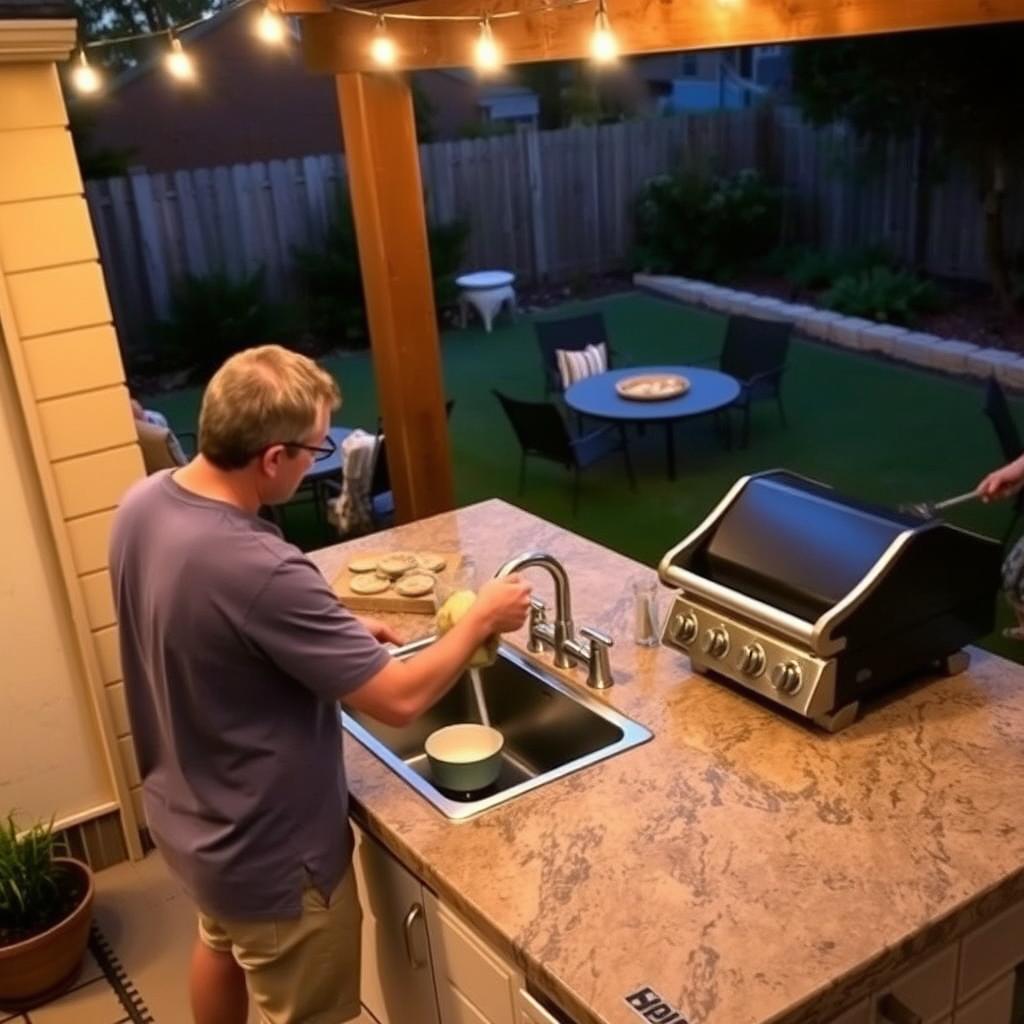
Outdoor Cooking Station
Elevate your outdoor kitchen or BBQ area with a sink for food prep, handwashing, and cleanup. It’s the difference between a grill and a complete outdoor cooking experience.
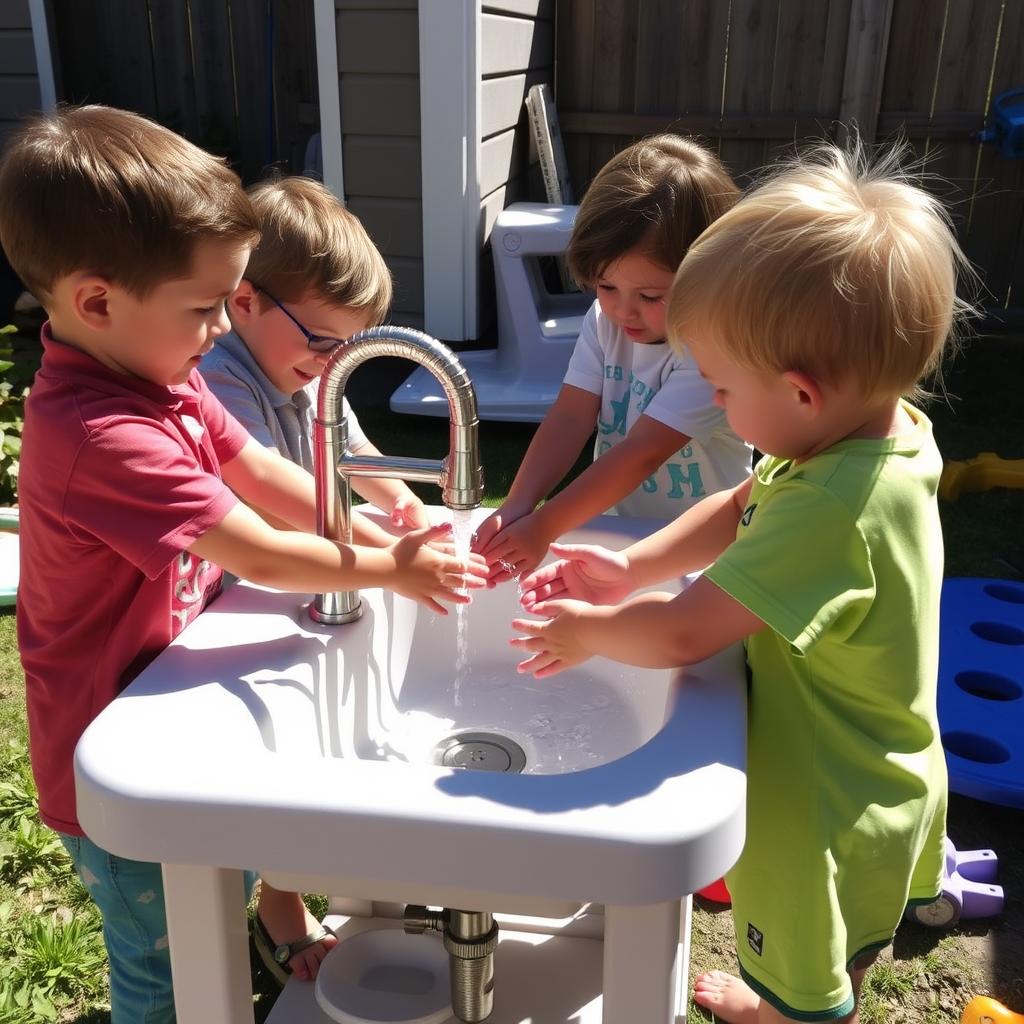
Family-Friendly Cleanup
From messy outdoor projects to sticky s’mores fingers, an outdoor sink provides a convenient cleanup station for family activities without constant trips indoors.
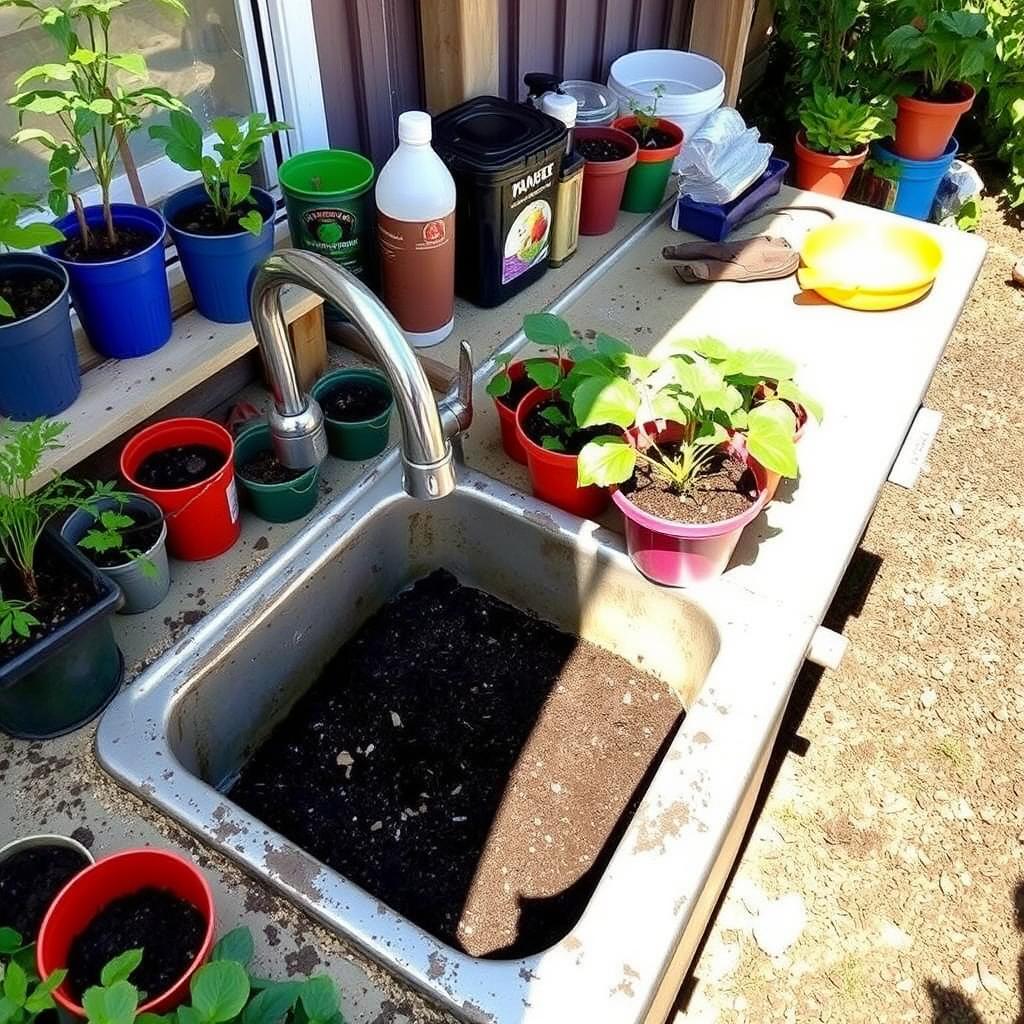
Plant Care Hub
Create a dedicated space for potting plants, filling watering cans, and other plant care tasks with easy access to water and simple cleanup.
DIY vs Pre-Built Outdoor Sink: Quick Comparison
Before we explore each option in detail, here’s a side-by-side comparison to help you understand the key differences:
| Criteria | DIY Outdoor Sink | Pre-Built Outdoor Sink |
| Average Cost | $150-$600 | $500-$2,000+ |
| Time Investment | 8-20+ hours | 1-3 hours |
| Skill Level Required | Moderate to High | Low |
| Customization | Unlimited | Limited to available models |
| Durability | Varies by materials used | Generally high |
| Plumbing Complexity | High | Moderate |
| Resale Value Added | Moderate | High |
DIY Outdoor Sink: The Hands-On Approach
Building your own outdoor sink offers creative freedom and potential cost savings. Let’s explore what’s involved in the DIY approach.
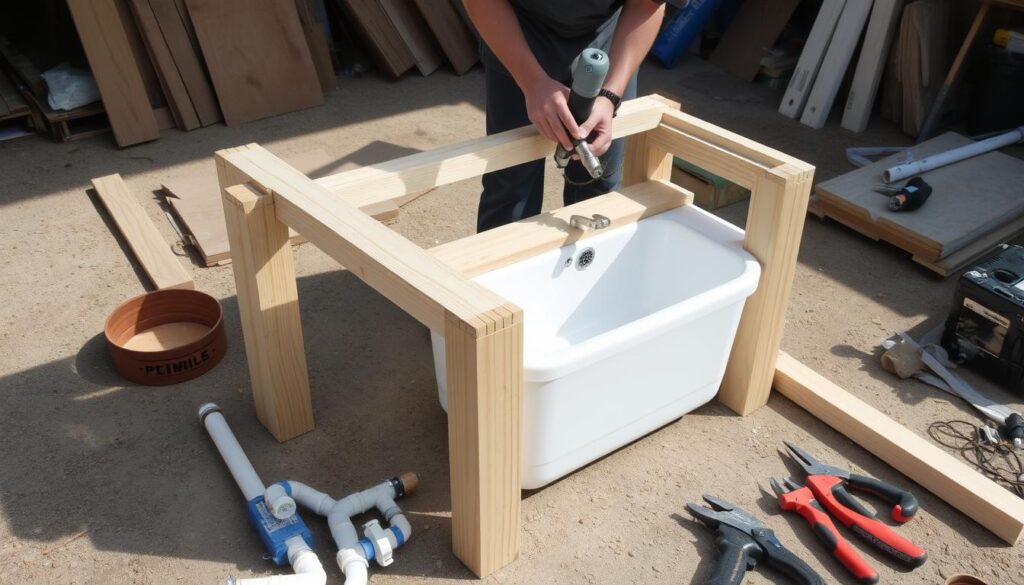
Advantages of DIY Outdoor Sinks
- Significant cost savings (typically 30-60% less than pre-built)
- Complete customization of size, height, materials, and design
- Ability to match existing outdoor structures or furniture
- Satisfaction of creating something with your own hands
- Flexibility to incorporate recycled or repurposed materials
- Can be built in phases as budget allows
- No shipping or delivery concerns
Disadvantages of DIY Outdoor Sinks
- Requires significant time investment and planning
- Needs basic carpentry and plumbing skills
- May require specialized tools you don’t already own
- Potential for mistakes that could be costly to fix
- Plumbing connections can be challenging for beginners
- Weather resistance depends on your material choices
- May require permits depending on your location
Essential Materials and Tools for DIY Outdoor Sinks
If you’re leaning toward the DIY route, here’s what you’ll need to gather before starting your project:
Basic Materials
- Sink basin – Stainless steel, copper, or composite
- Faucet – Outdoor-rated with freeze protection
- Cabinet materials – Pressure-treated lumber, concrete blocks, or weather-resistant alternatives
- Countertop material – Concrete, stone, tile, or composite
- Plumbing supplies – PVC pipes, connectors, drain assembly
- Water supply connection – Hose bibb adapter or direct plumbing
- Drainage solution – French drain, dry well, or connection to existing drainage
- Waterproofing materials – Sealants, caulk, waterproof membrane
Essential Tools
- Power drill with various bits
- Circular saw or miter saw
- Jigsaw (for cutting a sink hole)
- Level and measuring tape
- Pipe wrench and adjustable wrench
- Screwdriver set
- Caulking gun
- Safety equipment – Gloves, eye protection, ear protection
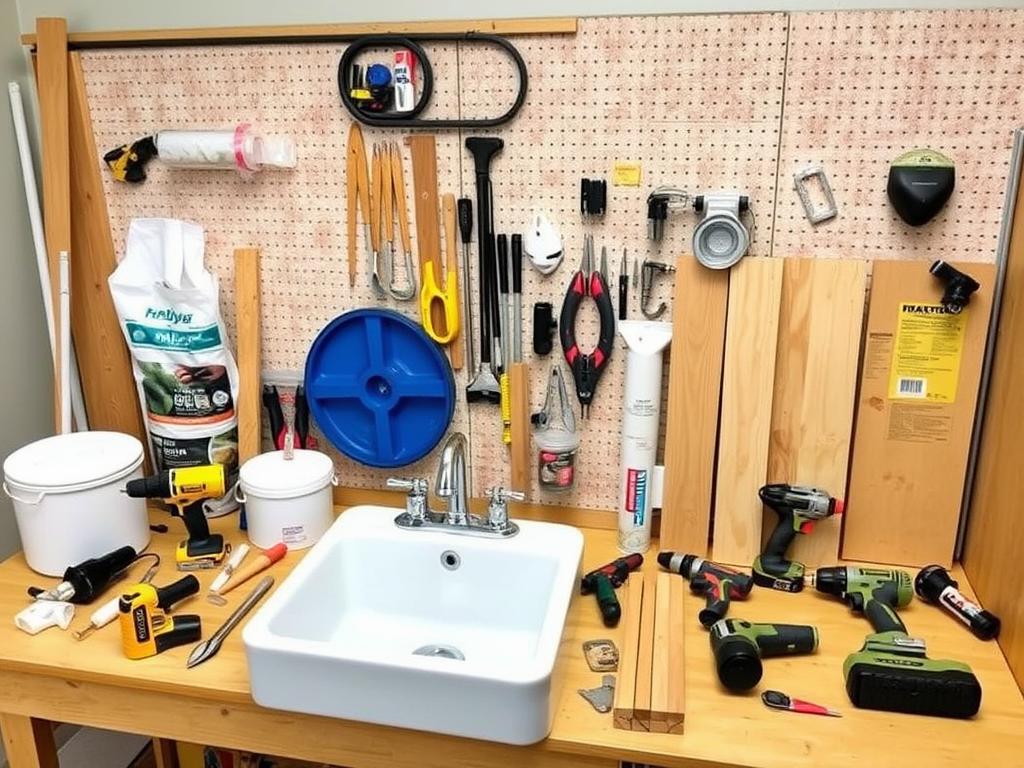
Real-World DIY Outdoor Sink Examples
Looking for inspiration? Here are three successful DIY outdoor sink projects with different approaches and materials:
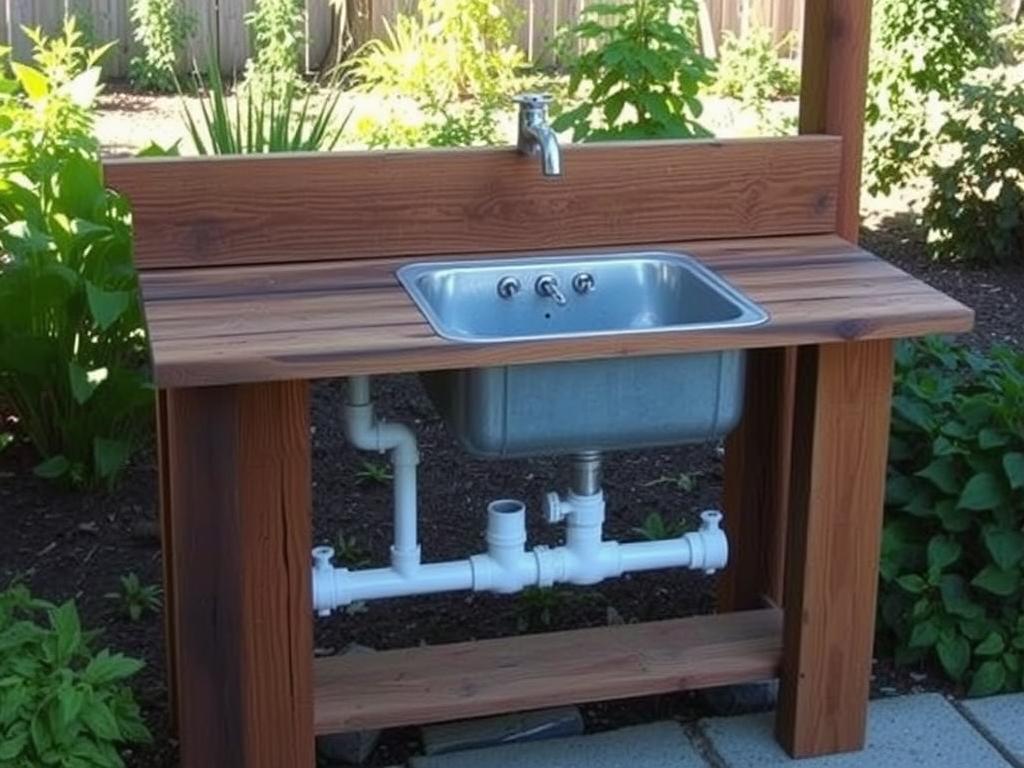
Rustic Garden Sink
Materials: Reclaimed barn wood, galvanized metal basin, garden hose connection
Cost: Approximately $175
Time: Weekend project (12 hours)
Challenges: Weatherproofing the wood, creating a stable base on uneven ground
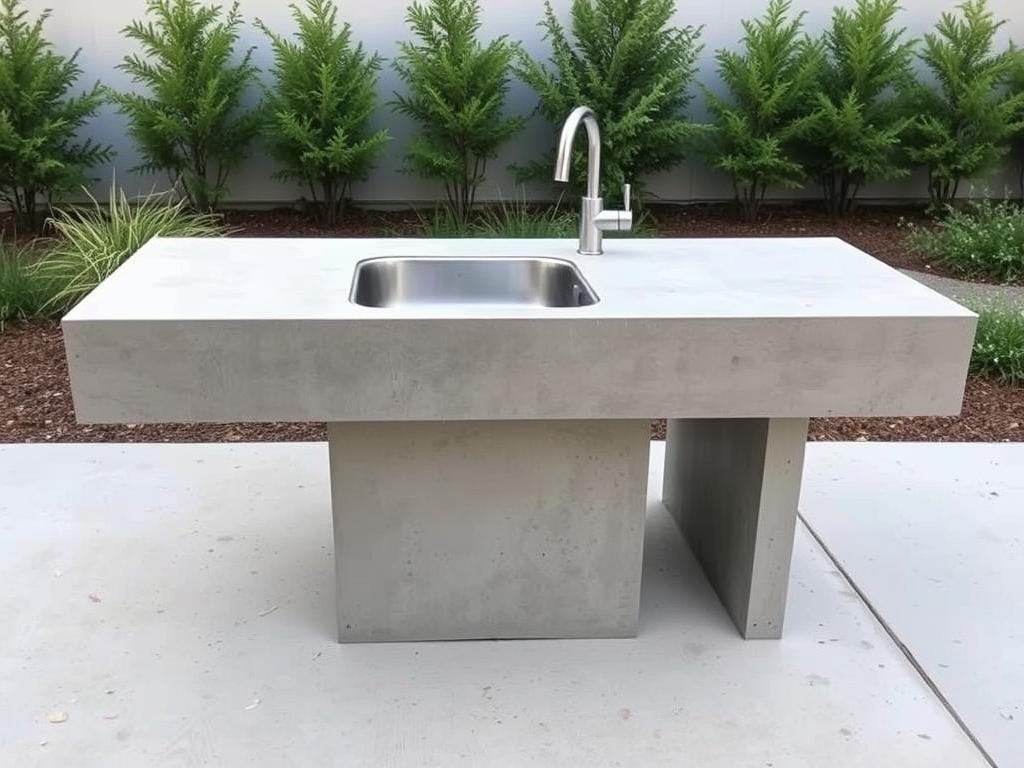
Modern Concrete Sink Station
Materials: Concrete blocks, poured concrete countertop, stainless steel sink, plumbed water line
Cost: Approximately $425
Time: 3 weekends (25 hours)
Challenges: Working with concrete forms, ensuring proper drainage slope
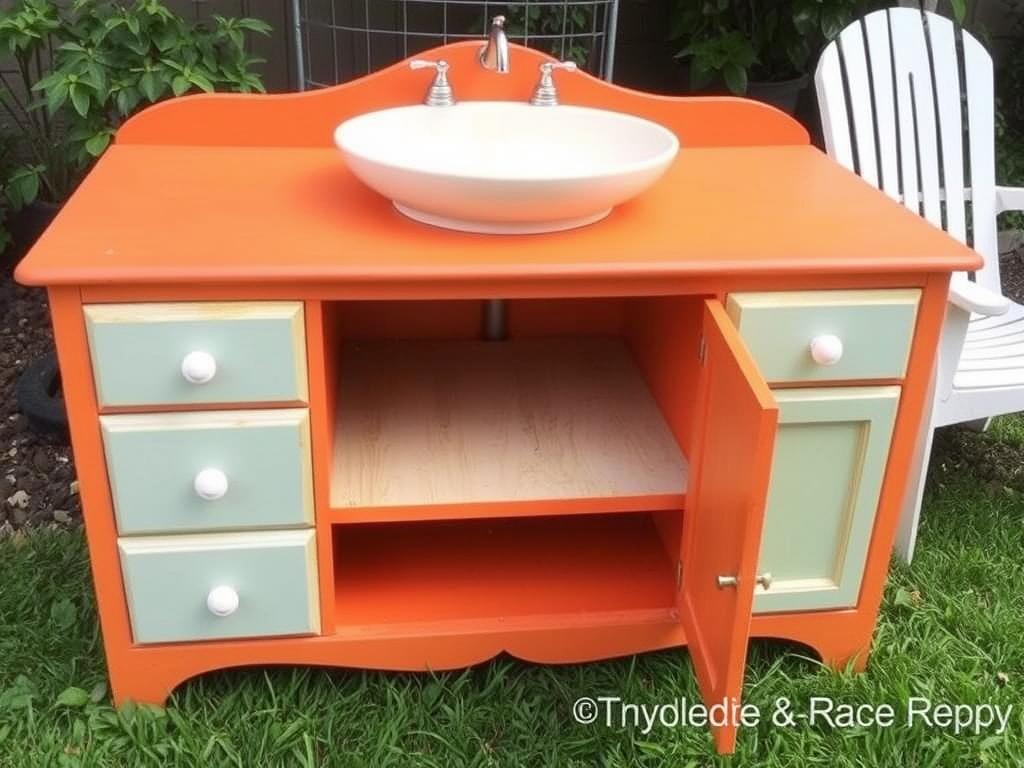
Upcycled Furniture Sink
Materials: Repurposed dresser, composite sink, marine-grade finish, rain barrel drainage
Cost: Approximately $250
Time: 2 weekends (16 hours)
Challenges: Waterproofing furniture, adapting an interior piece for outdoor use
Ready to Build Your Own Outdoor Sink?
Get our step-by-step DIY outdoor sink plans with detailed material lists, cutting diagrams, and plumbing instructions for three different design styles.
Pre-Built Outdoor Sink: The Convenient Solution
If you value convenience and professional quality, a pre-built outdoor sink might be your ideal choice. These ready-to-install units offer immediate functionality with minimal effort.
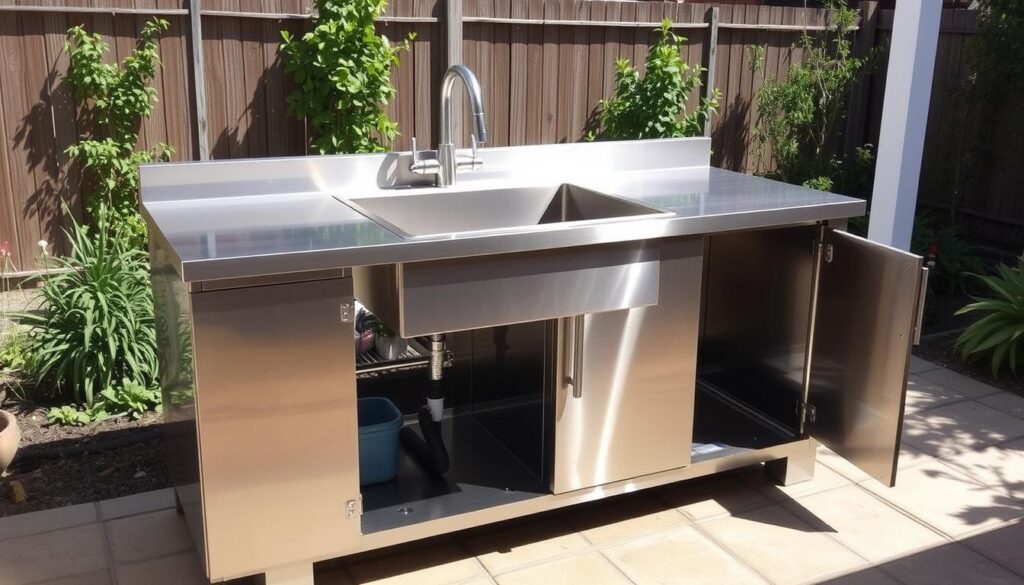
Advantages of Pre-Built Outdoor Sinks
- Quick and easy installation (often in just a few hours)
- Professional-grade materials and construction
- Weather-resistant designs specifically engineered for outdoor use
- Warranty protection for components
- Consistent, polished appearance
- No specialized tools or skills required
- Often includes integrated features like storage or cutting boards
Disadvantages of Pre-Built Outdoor Sinks
- Significantly higher cost than DIY options
- Limited customization options
- Shipping costs can be substantial for larger units
- May not perfectly match existing outdoor structures
- Still requires plumbing connections
- Limited size and configuration options
- May require professional help for installation
Key Features to Look for in Pre-Built Outdoor Sinks
When shopping for a pre-built outdoor sink, these are the essential features that ensure durability, functionality, and value:
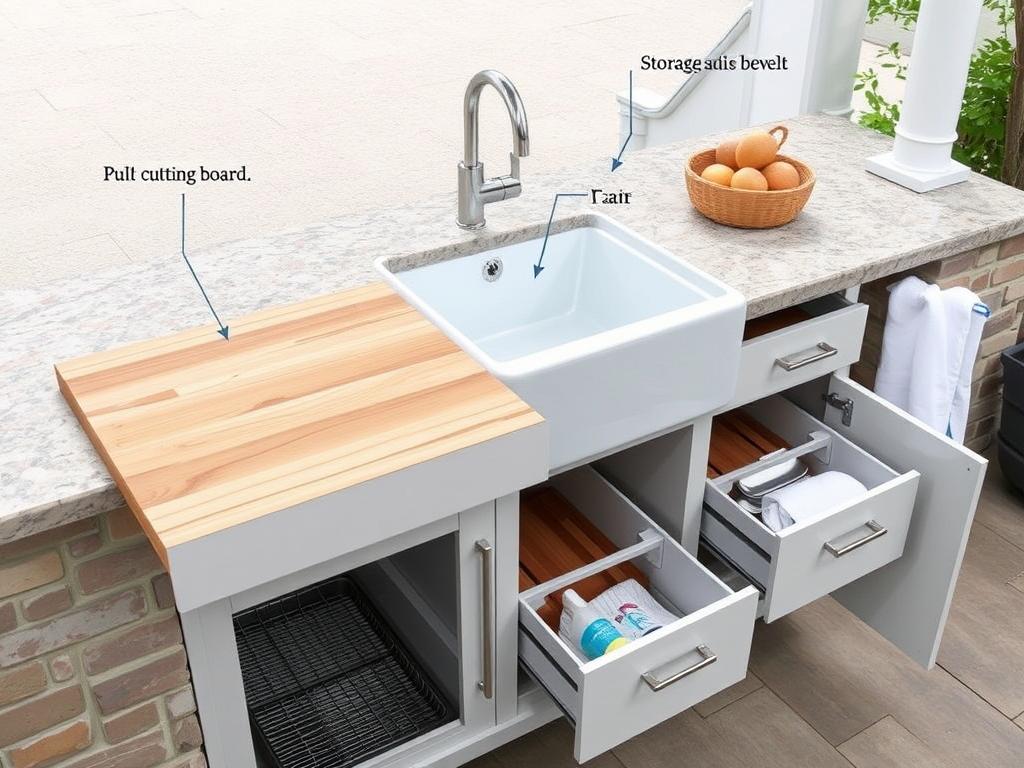
Integrated Features
Many pre-built sinks include valuable extras like cutting boards, storage drawers, towel racks, and garbage disposal access. These features enhance functionality and convenience.
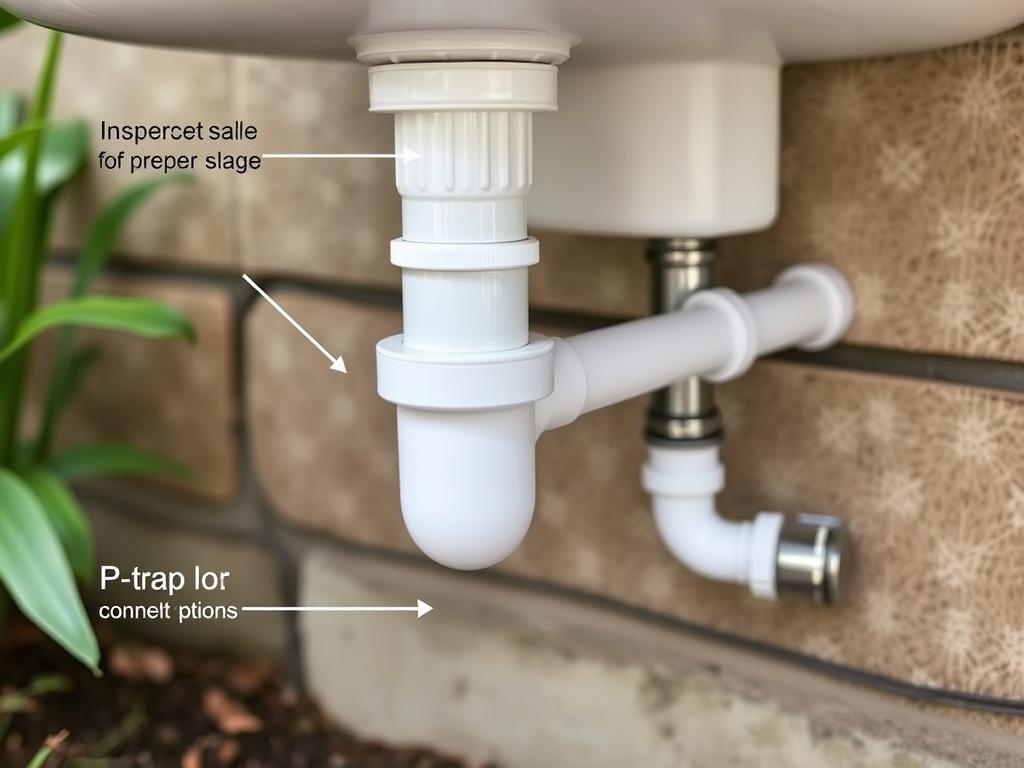
Drainage Solutions
The best pre-built sinks offer flexible drainage options, including standard plumbing connections, gray water systems, or self-contained options for locations without existing plumbing.
Recommended Pre-Built Outdoor Sink Models
Based on quality, features, and customer satisfaction, here are three standout pre-built outdoor sink options:
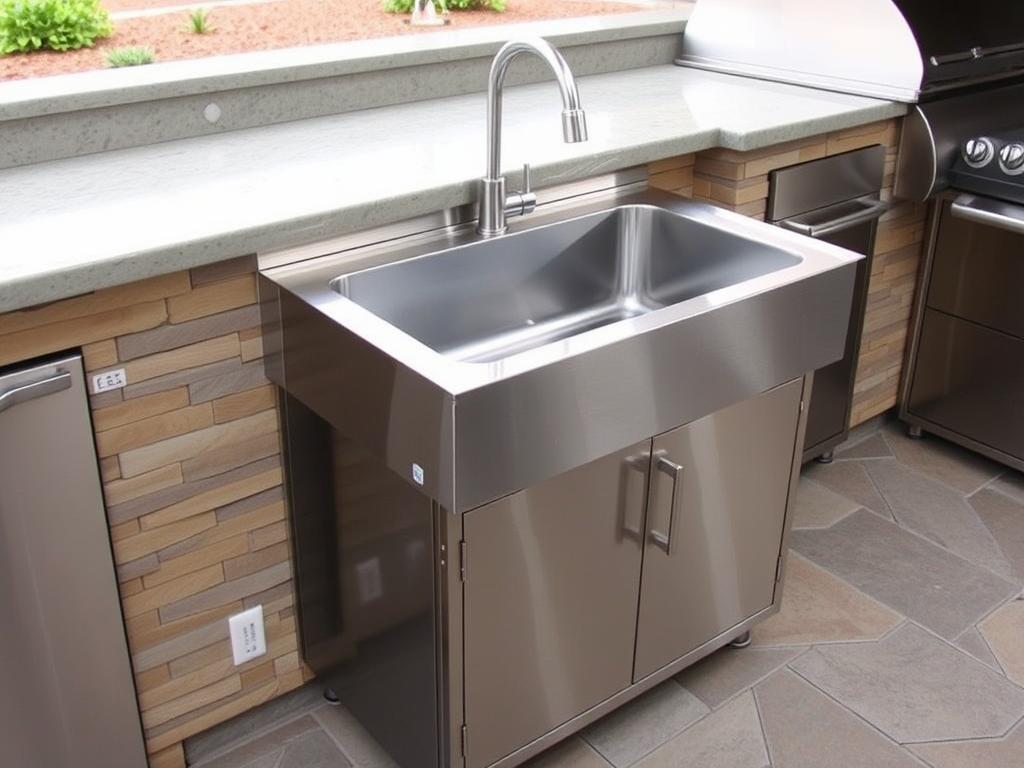
Coyote Outdoor Living 21″ Sink
Price: $899
Features: 304 stainless steel, faucet, soap dispenser, cutting board, stainless steel cover
Best for: Complete outdoor kitchens, frequent entertainers
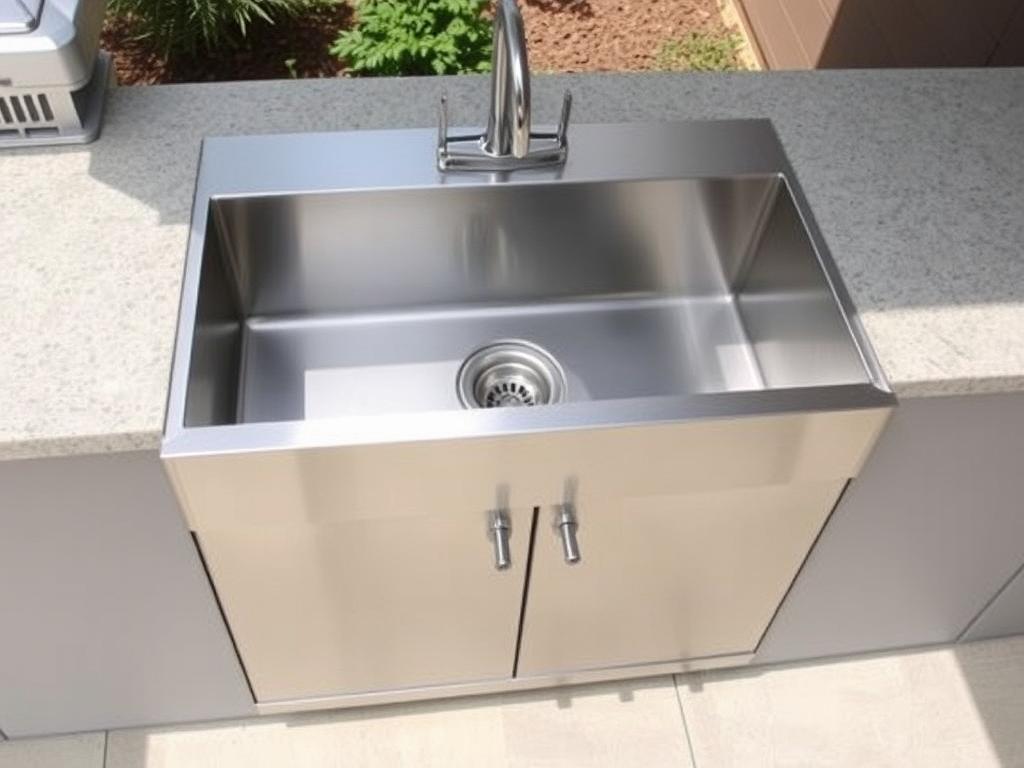
Summerset 19″ Undermount Sink
Price: $510
Features: 304 stainless steel, hot and cold water swivels, drain stopper
Best for: Mid-range outdoor kitchens, value-conscious buyers
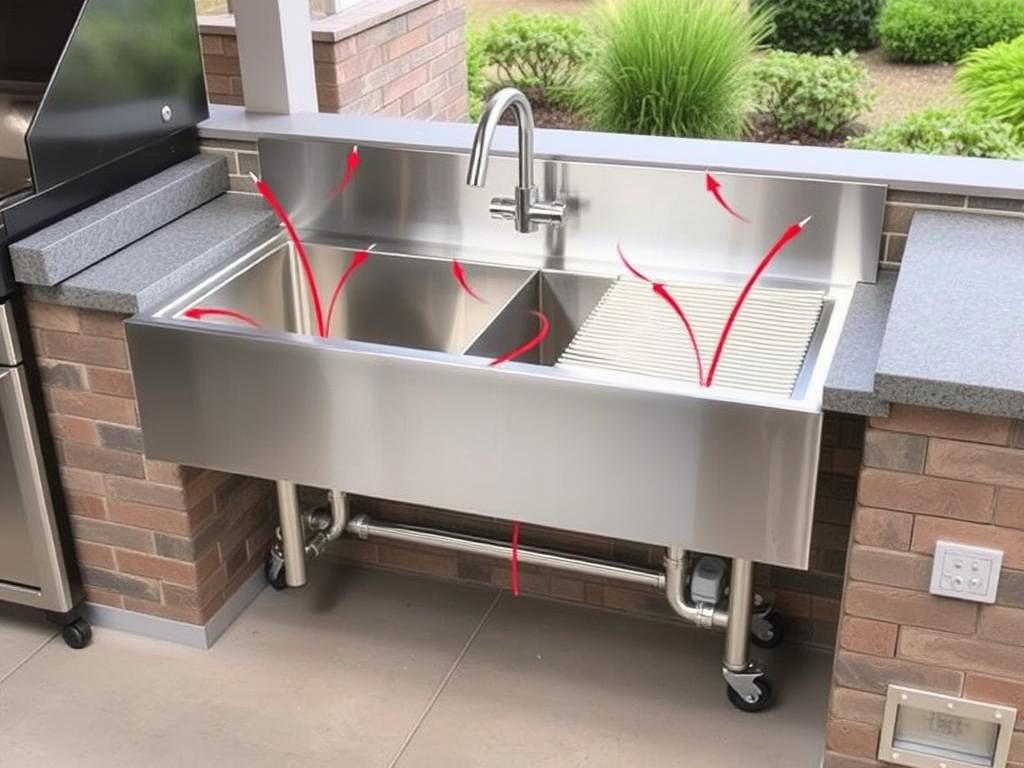
BBQ Guys Signature 23″ Sink
Price: $112 (sink only)
Features: 304 stainless steel, drain strainer, and optional faucet
Best for: Budget-conscious DIYers, custom installations
Cost Comparison: DIY vs Pre-Built Outdoor Sinks
Understanding the true cost difference between DIY and pre-built options can help you make a more informed decision:
| Expense Category | DIY Outdoor Sink | Pre-Built Outdoor Sink |
| Base Materials/Unit | $100-400 | $500-1,500 |
| Sink Basin & Faucet | $75-200 | Included |
| Plumbing Supplies | $50-150 | $50-150 |
| Tools (if not owned) | $100-300 | $0-50 |
| Shipping/Delivery | $0-50 | $50-200 |
| Professional Help (if needed) | $0-300 | $0-300 |
| Total Range | $150-800 | $600-2,200 |
Cost-Saving Tip: For DIY projects, check local building material reuse centers or online marketplaces for discounted or free materials. For pre-built sinks, look for end-of-season sales or floor models for significant discounts.
Time Investment: DIY vs Pre-Built
Your available time and project timeline are crucial factors in deciding between DIY and pre-built options:
DIY Time Breakdown
- Research and planning: 2-4 hours
- Gathering materials: 2-6 hours
- Building the structure: 4-12 hours
- Installing the sink: 1-3 hours
- Plumbing connections: 2-8 hours
- Finishing touches: 1-4 hours
Total DIY Time: 12-37 hours (typically spread over multiple weekends)
Pre-Built Time Breakdown
- Research and selection: 1-3 hours
- Delivery and unpacking: 1 hour
- Placement and assembly: 1-2 hours
- Plumbing connections: 1-3 hours
Total Pre-Built Time: 4-9 hours (often completed in a single day)
Customization Flexibility: Expressing Your Style
The level of personalization you desire plays a significant role in choosing between DIY and pre-built options:
“The difference between DIY and pre-built isn’t just about cost—it’s about whether you want a sink that looks like it belongs in a catalog or one that tells your unique story.”
Plumbing Considerations for Outdoor Sinks
Regardless of whether you choose DIY or pre-built, you’ll need to address these crucial plumbing aspects:
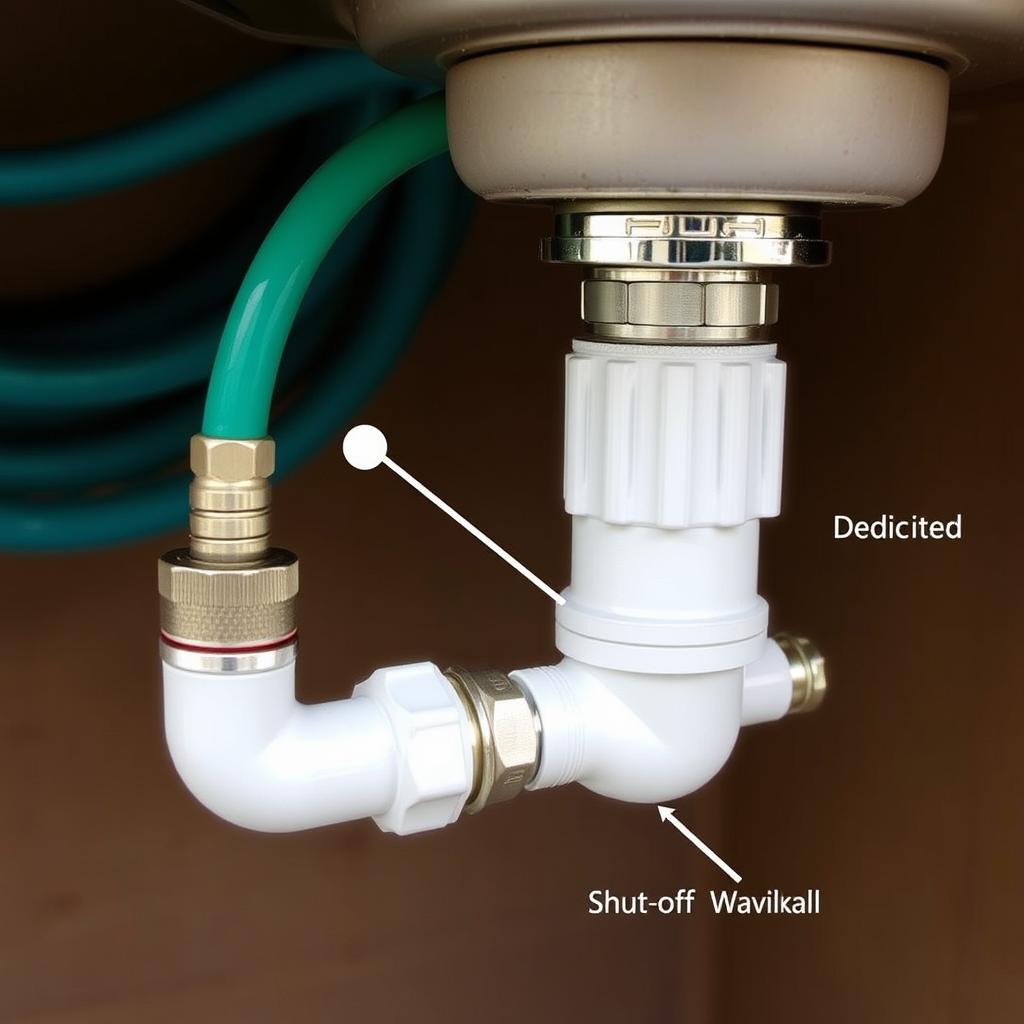
Water Supply Options
- Garden hose connection: Simplest but limited to cold water
- Dedicated water line: Allows for hot and cold water
- Self-contained system: Uses water tanks for remote locations
Both DIY and pre-built sinks require some form of water supply connection, though pre-built units sometimes include adapters for easier hookup.
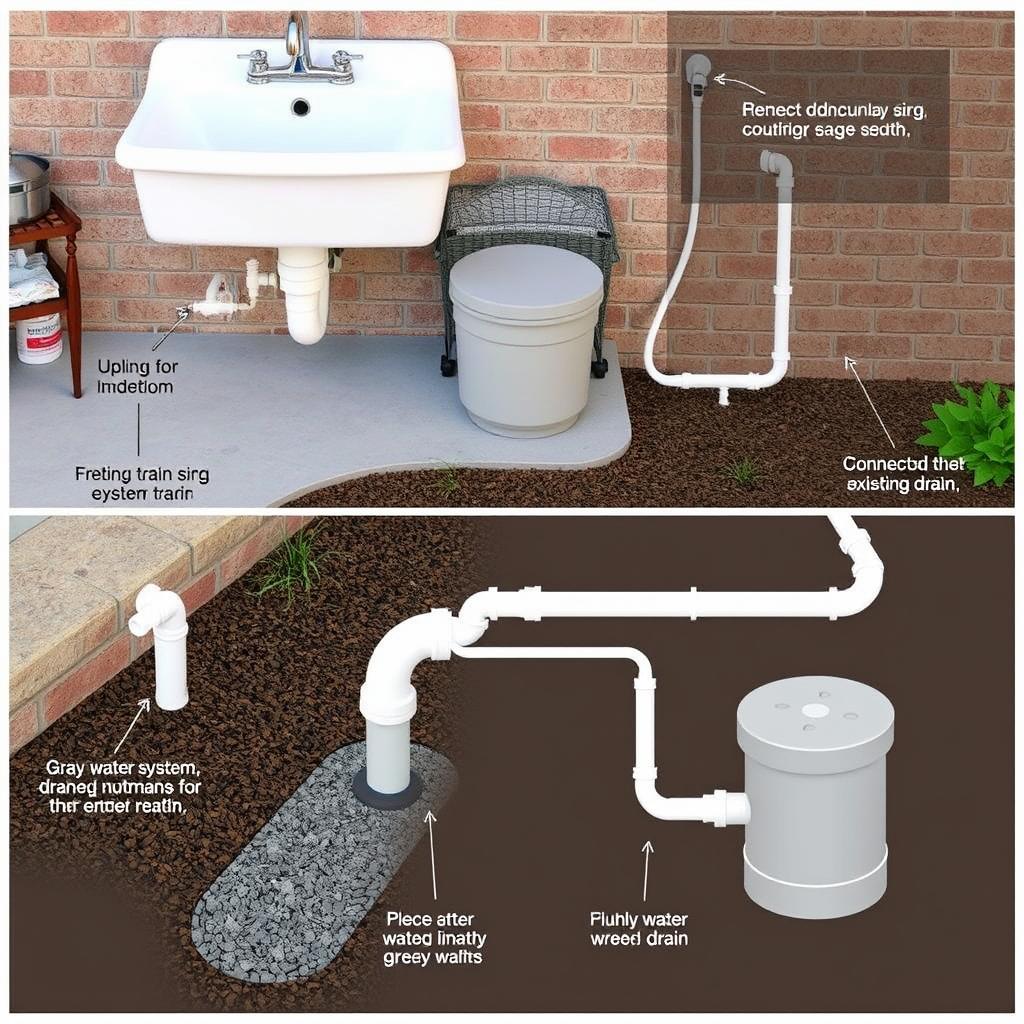
Drainage Solutions
- Direct plumbing: Connection to existing drain lines
- French drain or dry well: For gray water disposal
- Bucket system: Simple collection for plant watering
Local codes often dictate acceptable drainage options, so check regulations before finalizing your plans.
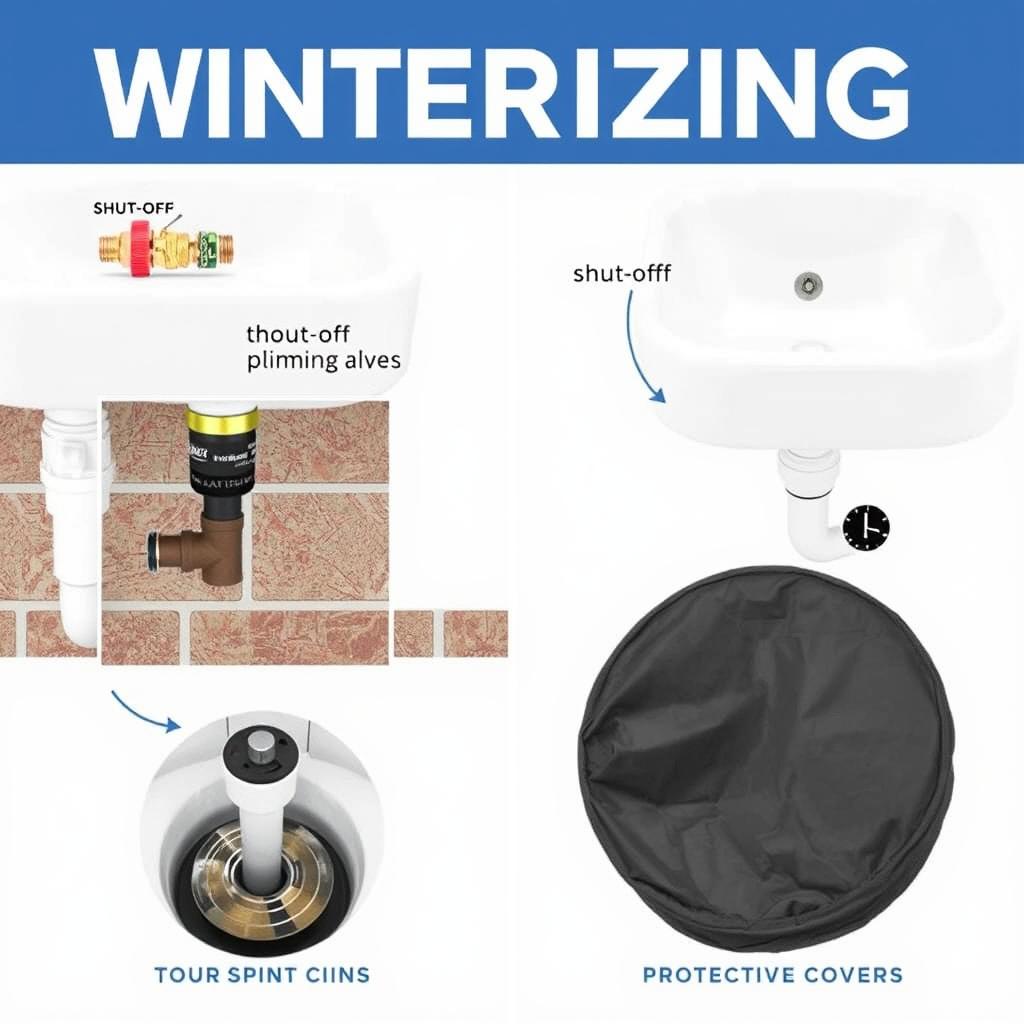
Freeze Protection
- Shut-off valves: Essential for seasonal use
- Drain points: Allow complete water removal
- Insulation: For pipes in colder climates
In regions with freezing temperatures, proper winterization is crucial to prevent damage to both DIY and pre-built sink systems.
Important: Many municipalities require permits for outdoor plumbing installations. Always check local building codes and consider consulting with a licensed plumber before finalizing your outdoor sink plans.
Decision Guide: Which Option Is Right for You?
Answer these questions to help determine whether a DIY or pre-built outdoor sink better aligns with your needs:
What’s your budget?
Choose DIY if: Your budget is under $500 and you already own basic tools.
Choose Pre-Built if: You have $600+ to invest and value time savings over cost savings.
How soon do you need your outdoor sink?
Choose DIY if: You have several weekends available and aren’t in a rush.
Choose Pre-Built if: You want your sink installed and functional within days.
What’s your skill level with tools and building?
Choose DIY if: You’re comfortable with basic carpentry, have experience with simple plumbing, and enjoy hands-on projects.
Choose Pre-Built if: You have limited building experience or prefer not to deal with construction challenges.
How important is customization to you?
Choose DIY if: You have specific design ideas or need a non-standard size/configuration.
Choose Pre-Built if: Standard designs meet your needs, and professional appearance is important.
What’s your long-term plan for your outdoor space?
Choose DIY if: You enjoy updating your space regularly or might want to modify the sink later.
Choose Pre-Built if: You’re creating a permanent outdoor kitchen or planning to sell your home soon.
Still Not Sure Which Option Is Best For You?
Take our quick 2-minute assessment to receive a personalized recommendation based on your specific needs, skills, and preferences.
Maintenance Considerations
The ongoing care requirements differ between DIY and pre-built outdoor sinks:
DIY Sink Maintenance
- Regular inspection of wood or other natural materials for weathering
- Periodic resealing of countertops and wooden components
- Checking for loose fasteners due to expansion/contraction
- Potential need for structural repairs over time
- Seasonal maintenance to address weather damage
DIY sinks typically require more ongoing maintenance, especially if built with natural materials that are more susceptible to weather damage.
Pre-Built Sink Maintenance
- Simple cleaning of stainless steel or composite surfaces
- Checking for loose fittings or connections
- Following the manufacturer’s winterization guidelines
- Occasional lubrication of moving parts
- Replacement of any worn components (often available from manufacturer)
Pre-built sinks generally require less maintenance due to their weather-resistant materials and professional construction techniques.
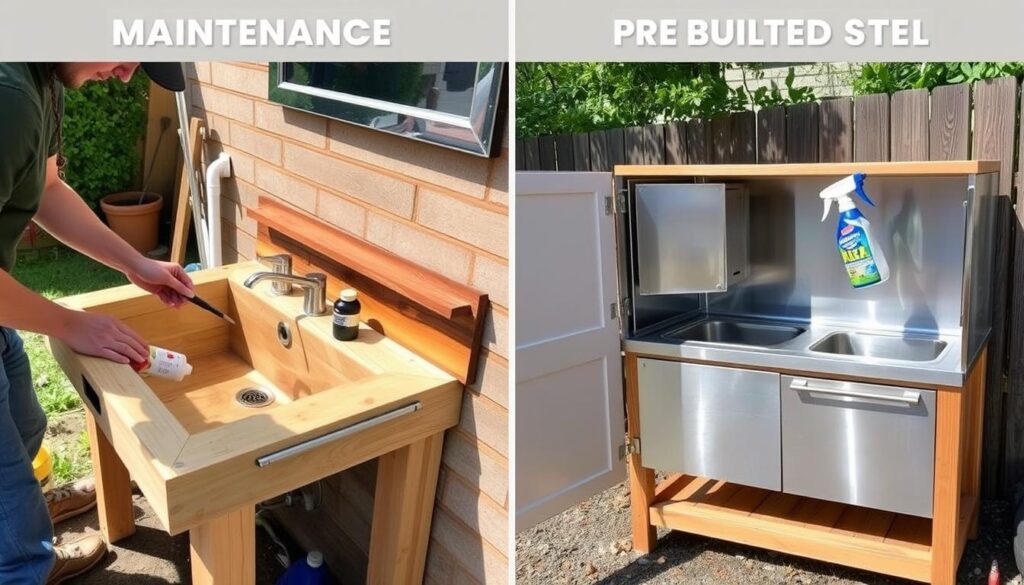
Conclusion: Making Your Final Decision
Both DIY and pre-built outdoor sinks offer viable paths to enhancing your backyard functionality. Your decision ultimately comes down to balancing your budget, skills, timeline, and desired outcome.
Choose DIY If You:
- Enjoy hands-on projects and have basic building skills
- Are working with a tighter budget
- Want complete creative control over the design
- Have time to dedicate to the project
- Don’t mind ongoing maintenance
Choose Pre-Built If You:
- Value convenience and quick installation
- Prefer professional-grade materials and construction
- Want warranty protection
- Have limited building experience
- Need a solution that adds immediate value to your home
Remember that there’s also a middle ground: you can purchase a pre-built sink basin and faucet but build a custom enclosure, combining the best of both approaches. This hybrid method offers professional-grade components with the creative freedom of DIY construction.
Whichever route you choose, an outdoor sink will transform your backyard experience, making gardening, cooking, and outdoor entertaining more convenient and enjoyable.
Related Articles
1- How to Choose the Best Outdoor Sink for Your Space
2- Outdoor Stainless Steel Sinks: Rugged and Reliable in 2025

